Nearly 30 years into its history, Mark Of The Unicorn's flagship recording DAW makes its first appearance as a Windows application. How worried should MOTU's competitors be?
Mark Of The Unicorn's Digital Performer has a long history. It originated in the mid-'80s as a MIDI sequencing package for Apple computers called Performer, and has evolved through numerous iterations to the current incarnation: Digital Performer 8. Throughout that history, DP has attracted a dedicated following, especially in the world of music for picture. And while its user base is perhaps not as large as the likes of Cubase, Logic or Pro Tools, DP is a well-featured system that is as capable as its peers of catering to every aspect of the music-production process.
Given that DP has been Mac-only since its first release, many were surprised when MOTU announced that DP8 would be available in a Windows version as well. The Mac OS version saw the light of day first, late in 2012 — but, true to their word, MOTU then released the Windows version in May this year and, bar some minor cosmetic differences, the feature sets on the two platforms are the same. This means that DP8 for Windows is, right from its first release, a heavyweight music production environment. So, if you are a PC musician looking for a top-of-the-line DAW environment to work in, is DP8 for Windows worth considering alongside the obvious competition?
Operation is almost identical on both platforms, and the bulk of the user-interface features in DP8 are retained from DP7. Instead of re-treading the same ground, then, after a very brief introduction to the key features, I'll leave you to dig back into Robin Bigwood's previous DP reviews: DP7, from March 2010 (/sos/mar10/articles/dp7.htm) and DP6, from November 2008 (/sos/nov08/articles/dp6.htm) would be the best places to start. I'll then focus here on the new features introduced in this version and, in particular, on the PC support. To that end, I conducted this review almost exclusively on a Windows 7-based PC.
One new feature is that Digital Performer can now be purchased by download (which is how my review copy was supplied). Once installed, however, MOTU have maintained their fairly low-key approach to copy protection based around a simple key-code entry. DP's documentation has always been comprehensive, and that tradition continues here with a PDF User Guide that comes in at nearly 1000 pages, plus additional PDFs covering getting started and the bundled plug-ins.
Established Performer
In terms of broad brush strokes, DP provides a sophisticated environment for working with MIDI and audio recording, sequencing and mixing. The interface is built around DP's Consolidated Window and Control Panel: the former provides a highly customisable frame into which you can arrange key sub-windows such as the Tracks window, Sequence Editor, Movie window, Waveform Editor, Mixing Board or Event List, while the latter provides the usual transport controls, plus access to a customisable set of additional controls, tools and information displays. Individual windows can also be separated from the Consolidated Window and 'floated' if preferred.
 I particularly like the Drum panel for editing MIDI drum parts with the 'grid with velocity' mode shown here.
I particularly like the Drum panel for editing MIDI drum parts with the 'grid with velocity' mode shown here.
A highlight of DP's comprehensive MIDI recording and editing features is the drum editor, while audio-manipulation options include pitch correction and pitch effects for monophonic audio such as vocals, plus very good track comping facilities. The mixing environment features the ability to carry out multiple mixes simultaneously, and includes some excellent mastering-style processing options. The QuickScribe notation creation/editing environment is also well implemented, and obviously useful for those who will eventually want their MIDI arrangements performed by live instruments.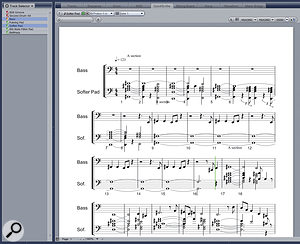 QuickScribe makes it very easy to provide lead sheets for live musicians. Previous versions of DP have built up an extensive collection of audio effects and virtual instruments although, as Robin noted in his DP7 review, the bundled instrument collection is perhaps not DP's strongest suit.
QuickScribe makes it very easy to provide lead sheets for live musicians. Previous versions of DP have built up an extensive collection of audio effects and virtual instruments although, as Robin noted in his DP7 review, the bundled instrument collection is perhaps not DP's strongest suit.
New Performer
While the Windows 7 and 8 compatibility might be the headline news, DP8 does come with a long list of new and improved features to tempt users new and old. Some of these are performance-related 'under-the-hood' things such as full 64-bit operation (enabling better use of large RAM configurations) and a complete reworking of the video playback engine so that it supports full 720 or 1080 HD video playback within a thumbnail, separate window, on a second monitor or streamed to a standard video display monitor if your computer has the necessary connectivity.
DP8 also includes 17 new effects plug-ins but, perhaps even more interesting for those with established computer-based music systems is that DP8 includes support for third-party effects and virtual instruments in the VST format — a big plus. Also new is a system called Punch Guard (see box), which allows you to retrieve a few seconds of audio both before and after a recording pass, and better support for MP3 export.
User-interface improvements include the ability to embed the Control Panel in the main Consolidated Window and customise its contents.![]() The Control Panel can house a tremendous range of buttons for quick access to key functions and, in version 8, can also be embedded within the Consolidated Window. This is an excellent cosmetic option, and means you can keep DP confined to a single window if you so wish. DP8 also includes a collection of new themes that allow you to change the look of the interface to suit your mood. I adopted the earlier Alloy theme, but there are some nice options amongst the version 8 additions, although the faux wood look of Hi-Fi and Deluxe wouldn't be to my own taste. A new plug-in chooser is included for quickly finding the effects you are after
The Control Panel can house a tremendous range of buttons for quick access to key functions and, in version 8, can also be embedded within the Consolidated Window. This is an excellent cosmetic option, and means you can keep DP confined to a single window if you so wish. DP8 also includes a collection of new themes that allow you to change the look of the interface to suit your mood. I adopted the earlier Alloy theme, but there are some nice options amongst the version 8 additions, although the faux wood look of Hi-Fi and Deluxe wouldn't be to my own taste. A new plug-in chooser is included for quickly finding the effects you are after The Plug-in Chooser makes finding the required plug-in very straightforward., while the Graphic Editor has been re-branding as the MIDI Editor (which makes much more sense). And this list, of course, represents only the highlights. There are plenty of other additions and improvements on offer, of which a full list is available on MOTU's web site.
The Plug-in Chooser makes finding the required plug-in very straightforward., while the Graphic Editor has been re-branding as the MIDI Editor (which makes much more sense). And this list, of course, represents only the highlights. There are plenty of other additions and improvements on offer, of which a full list is available on MOTU's web site.
Plug-in Power
As with DP7, some of the more obvious new offerings are found amongst the bundled plug-ins. There are 17 new items, bringing the total collection of effects and virtual instruments up to 84. DP8 adds to DP7's guitar options by including new stomp-box-style effects, among them Analog Delay, Analog Flanger, Analog Phaser, Hi-Top Booster (based on a treble booster used by Eric Clapton and Brian May) and Dyna-Squash, modelled on the classic MXR Dynacomp. All these sound great, but perhaps the highlights for guitar players are the new ACE30 and Soloist guitar amp models. The Soloist amp plug-in. You just know it's going to rock because of all those valves.
The Soloist amp plug-in. You just know it's going to rock because of all those valves.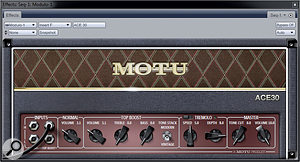 No prizes for guessing the source of inspiration behind the ACE30 amp model. There are no prizes for guessing the inspiration behind the former, while the latter is based on a Mesa Boogie Dual Rectifier and brings a much needed heavier, high-gain, 'rawk' flavour to DP8's guitar amp collection. It can do clean but is designed specifically for modern rock and metal styles. While the range of amps and effects now available doesn't match those found in some third-party software such as NI's Guitar Rig, the quality is very good.
No prizes for guessing the source of inspiration behind the ACE30 amp model. There are no prizes for guessing the inspiration behind the former, while the latter is based on a Mesa Boogie Dual Rectifier and brings a much needed heavier, high-gain, 'rawk' flavour to DP8's guitar amp collection. It can do clean but is designed specifically for modern rock and metal styles. While the range of amps and effects now available doesn't match those found in some third-party software such as NI's Guitar Rig, the quality is very good.
DP7 introduced Live Room G, a modelled guitar speaker cabinet plug-in that impressed Robin in his March 2010 review with its flexibility and authentic sound. This time around we also get Live Room B, which — surprise, surprise — does a similar job for bass guitar cabinets. Live Room B brings ultra-realistic cabinet/microphone/room modelling for bass cabinets, complementing the existing Live Room G plug-in. This was my first encounter with both of these and I must say I'm also impressed. While most decent guitar/bass amp sims now include some form of cabinet/microphone modelling, the Live Room plug-ins take this to another level in terms of the combination of cabinet configurations, microphone options and placements, and the EQ. It's not just a collection of fancy features either: the sound is remarkably authentic. I'm sure there is an interesting 'is it real or fake?' experiment to be organised in a top-notch studio with a collection of golden-eared engineers.
Live Room B brings ultra-realistic cabinet/microphone/room modelling for bass cabinets, complementing the existing Live Room G plug-in. This was my first encounter with both of these and I must say I'm also impressed. While most decent guitar/bass amp sims now include some form of cabinet/microphone modelling, the Live Room plug-ins take this to another level in terms of the combination of cabinet configurations, microphone options and placements, and the EQ. It's not just a collection of fancy features either: the sound is remarkably authentic. I'm sure there is an interesting 'is it real or fake?' experiment to be organised in a top-notch studio with a collection of golden-eared engineers.
Of the other new plug-ins, Dynamic Equalizer, Spatial Maximizer and Subkick caught my eye (and ear). The Dynamic Equalizer plug-in combines spectrum analysis with a five-band EQ and compression. This can be applied to any individual track but is particularly useful for dealing with group channels such as drum submixes, or even in a mastering context. The combination of the spectrum display, the graphical representation of the EQ settings being applied and the compression metering for each band make it very easy to focus in on particular aspects of the sound, especially as individual EQ/compression bands can be soloed. Whether it's for corrective or creative use, this is a powerful tool. 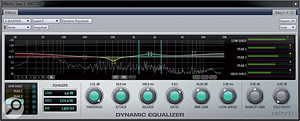 The Dynamic Equalizer plug-in is a very powerful addition to the effects line-up in DP8; versatile and flexible, it can work at track, group or mix level.
The Dynamic Equalizer plug-in is a very powerful addition to the effects line-up in DP8; versatile and flexible, it can work at track, group or mix level. Spatial Maximizer takes the same concept a step further, as you get a similar set of processing options but with independent control over the Middle and Sides content of the audio. Most 'stereo enhancement' plug-ins are fairly simple affairs, offering a couple of controls to the user; and while you can easily abuse them and do more damage than good, equally, you don't get scalpel-like control. With Spatial Maximizer, that's exactly what you get, but I suspect it requires considerably more experience than I acquired during testing in order to really get the best from it and avoid destroying the stereo imaging of your mix. That said, it's very easy to hear the potential on offer, and in the right hands (and ears) it would be a very interesting mastering-style tool. Alongside DP's existing Masterworks Limiter, Compressor, Equalizer and Leveler, it represents a powerful combination of tools for DIY mastering.
Spatial Maximizer takes the same concept a step further, as you get a similar set of processing options but with independent control over the Middle and Sides content of the audio. Most 'stereo enhancement' plug-ins are fairly simple affairs, offering a couple of controls to the user; and while you can easily abuse them and do more damage than good, equally, you don't get scalpel-like control. With Spatial Maximizer, that's exactly what you get, but I suspect it requires considerably more experience than I acquired during testing in order to really get the best from it and avoid destroying the stereo imaging of your mix. That said, it's very easy to hear the potential on offer, and in the right hands (and ears) it would be a very interesting mastering-style tool. Alongside DP's existing Masterworks Limiter, Compressor, Equalizer and Leveler, it represents a powerful combination of tools for DIY mastering.
If you suffer from occasional kick drum loss in your mixes, the new Subkick plug-in will certainly appeal. Placed as an insert plug-in on your kick drum track, Subkick triggers itself from the kick drum and adds synthesized low-frequency sound. You can dial in the sensitivity, pitch, resonance and drive of the sound to suit, and also set the blend between your recorded track and the synthesized kick sound. Providing your original kick track doesn't have too much spill from other drums, this really is a doddle to use and is surprisingly flexible, enabling you to ensure your kick drum holds its own in even the busiest of mixes. However, getting the levels right requires a monitoring system that can reproduce the low frequencies involved; if you're mixing on headphones or standard nearfields, you might not be able to judge just how much low-frequency energy you are actually adding.
Placed as an insert plug-in on your kick drum track, Subkick triggers itself from the kick drum and adds synthesized low-frequency sound. You can dial in the sensitivity, pitch, resonance and drive of the sound to suit, and also set the blend between your recorded track and the synthesized kick sound. Providing your original kick track doesn't have too much spill from other drums, this really is a doddle to use and is surprisingly flexible, enabling you to ensure your kick drum holds its own in even the busiest of mixes. However, getting the levels right requires a monitoring system that can reproduce the low frequencies involved; if you're mixing on headphones or standard nearfields, you might not be able to judge just how much low-frequency energy you are actually adding.
While the plug-ins described above represent my personal favourites from the new additions, DP does include a good crop of other excellent plug-ins, both new and old. For example, both ProVerb and Plate can create very capable reverb treatments. And although POLAR isn't strictly a plug-in, as a built-in looper tool, it has some fun creative possibilities. On the flip side, however, MOTU have not expanded DP's collection of virtual instruments in this release. This has never really been a strong point of DP and, in terms of the bundled instrument plug-ins at least, version 8 doesn't move things forward.
VST Is For Versatility
That's not to say that MOTU haven't got a strategy here, though, and in focusing instead upon integrating VST support into version 8, rather than trying to compete with well-established third-party virtual instruments with their own equivalents, they have opened up DP to allow the best of that VSTi world inside. Personally, I think this is a sensible and pragmatic approach that gives DP users freedom to select from the formidable range of virtual instruments currently available.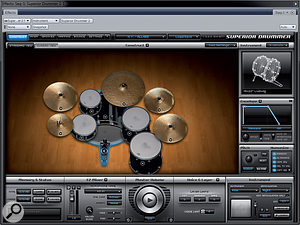
I experimented with a number of third-party VST plug-ins within DP8, including Toontrack's Superior Drummer 2, Ueberschall's Elastik and a couple of Steinberg VST instruments, and, in the main, things worked smoothly enough, though I did experience a few hiccups. For example, the graphical interface of SD2 occasionally seemed sluggish, though the actual triggering of samples wasn't affected, and, after I'd installed one particular plug-in, DP8 simply crashed a couple of times on start-up and proceeded to send an error report to MOTU. Although I didn't lose any work, and disabling the offending plug-in resolved the issue, this kind of behaviour is obviously not desirable.
Windows Performance
During my testing, I used DP8 on a dual-core PC laptop, a quad-core i7 PC with 16GB of RAM — both running Windows 7 — and, just for completeness, a well-specified mid-2011 iMac. On the laptop, which is probably close to the minimum spec recommended by MOTU, DP8 ran OK, but I was occasionally left waiting for things to happen. Things were generally much smoother on the desktop PC and the Mac.
Even so, I did experience some minor technical issues on the PC. For example, after the initial installation, I received a number of error messages associated with the audio engine. These became much less frequent when I upped the buffer value in my Focusrite Scarlett 8i6 ASIO driver slightly above where I would normally set it. I also experienced the occasional crash when DP8 just went belly up on me, as well as one or two odd experiences with third-party VST plug-ins and instruments. As mentioned above, in the main, these seemed to be associated with DP8 finding VST plug-ins for the first time; after some initial bedding in, things did run more smoothly.
Browsing the MOTU forums suggested that I am not the only PC user who has experienced some minor niggles — although niggles tend to be what most DAW forums are about, so I'm not sure I would read too much into that! The pragmatist in me is not surprised that there might be a few loose ends in the DP8 PC code: this is a sophisticated and complex application, and a few gremlins are perhaps inevitable even in a major update, let alone a very first release for a specific platform. Of course, the 'new user' in me might be just a little less sympathetic. That said, I'd fully expect MOTU to deal with any initial issues in an efficient and timely manner, and the fact that Digital Performer was already on the 8.0.4 release at the time of my testing suggests that tweaks are being made in response to specific user reports.
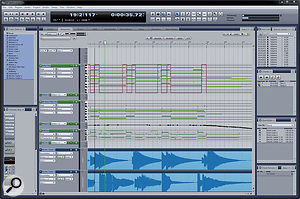 The DP8 Consolidated Window — here sporting the 'Alloy' theme — is highly customisable.
The DP8 Consolidated Window — here sporting the 'Alloy' theme — is highly customisable.
These initial problems aside, my PC DP8 experience was a very positive one. The range of audio effects plug-ins is impressive, especially those aimed at mastering applications. The flexibility of the user interface is commendable and means you can tailor your workspace to suit specific tasks at different stages of the production process. The MIDI drum editing is very well implemented, and I enjoyed experimenting with the POLAR looping options. The guitar amp modelling options offer quality if not quantity, at least in terms of the number of amps, and the speaker modelling is the most flexible and authentic I've ever experienced. DP8 is undoubtedly a heavyweight DAW package.
Best Performer?
In developing the Windows version of Digital Performer, MOTU have taken a brave decision and, minor niggles aside, they have implemented it in a commendably comprehensive fashion. DP8 is a formidable environment for music creation and, if you are a PC-based composer who has sometimes wondered whether DP's reputation for working to picture would offer you something extra, you can now experience it without needing to also move all your other musical tools from a PC to a Mac.
 The Mixing Board provides easy access to all the key tools, and the track display can be customised via the Track Selector panel.So who might buy DP8? While this is an evolutionary rather than revolutionary upgrade, existing users on the Mac will, I'm sure, find plenty within the new and improved feature set to justify the upgrade price. But what about other potential users? Moving to a new DAW is a big step, particularly if you have already invested a number of years in your existing DAW and its daily use puts food on the table. It involves a level of disorientation and unfamiliarity that is not unlike moving to a new country with a different language, and would apply to any user — Mac or PC — coming to DP for the first time from a different DAW.
The Mixing Board provides easy access to all the key tools, and the track display can be customised via the Track Selector panel.So who might buy DP8? While this is an evolutionary rather than revolutionary upgrade, existing users on the Mac will, I'm sure, find plenty within the new and improved feature set to justify the upgrade price. But what about other potential users? Moving to a new DAW is a big step, particularly if you have already invested a number of years in your existing DAW and its daily use puts food on the table. It involves a level of disorientation and unfamiliarity that is not unlike moving to a new country with a different language, and would apply to any user — Mac or PC — coming to DP for the first time from a different DAW.
If you are currently content in the world of Logic, Cubase, Reason or Pro Tools, I'm not sure if there are any killer features in DP8 that might persuade you to down tools and move ship. But, of course, forums also tell us that not everyone is happy with their current DAW, and if you are considering a move in any case, DP8 should most certainly be on your audition list. The same applies if you are looking to purchase your very first top-of-the-line DAW. DP8 offers a palette of features that is very much comparable to the obvious competition, with many strengths and relatively few weaknesses. However, like any top-of-the-line DAW, DP8 takes time to learn and, unlike some of the competition, there is no 'DP8 lite' in the product line to serve as a more gentle introduction.
Thankfully, whatever your position — potential buyer or just plain inquisitive — you don't have to commit yourself to a long-term relationship with DP8 without a bit of a dry run. Commendably, MOTU have a fully functional 30-day trial version of DP8 for both Mac and PC available for download. You can, therefore, try before you buy, put DP8 to the test on your own system, and see if the grass really is greener on MOTU's side of the fence. New users should be prepared for a bit of a learning curve but, Mac or PC, Digital Performer 8 undoubtedly provides a powerful and flexible music production system.
Proud As Punch
An interesting new feature in Digital Performer 8 is Punch Guard. DP provides both manual and automatic punch-in recording. The former is achieved simply by toggling the Record button on and off manually during playback, while the latter allows you to predefine the in/out points on the timeline and then cycle playback around a slightly longer stretch to allow yourself a couple of bars before and after the punch points.
Punch Guard provides you with a bit of an additional safety net, as it records some audio both before and after any punch points. If you miss the attack of a note punching in, or the tail of a note punching out, you can now retrieve it by simply dragging out the edge of the resulting Soundbite (MOTU's term for an audio region or event on the timeline). This all works very smoothly and, by default, you get four seconds and one second pre- and post-roll recording respectively, although you can adjust these settings within the Play and Record section of the Preferences and Settings panel if required.
Remote Control
Mac users have for some time been able to download a free DP Control app for their iPhone, iPod Touch or iPad, which lets them use their device's touchscreen as a remote control for Digital Performer. The app allows you to do various tasks such as operate the transport controls and basic mixing parameters. There is a PDF user guide to configuring the app and I had no problems getting it to work with DP8 under OS X.
The guide has not been updated since the Windows version of DP was released, and there are no instructions on using DP Control that are explicitly aimed at PC users. However, I did give this a go. It worked perfectly with the 32-bit version of DP8 but, using the 64-bit version, I couldn't get DP Control to establish a connection to my PC. Hopefully, MOTU will make the necessary updates required to overcome this, as remote control of transport functions from the other side of a recording room (behind your acoustic guitar/piano/vocal mic) is something that can be very convenient.
Pros
- PC users can now join in.
- Highly sophisticated music production environment with flexible workspace.
- Enough new features to keep existing users happy, of which some excellent effects plug-ins are particular highlights.
- VST support is a very welcome addition.
Cons
- The flip side of 'highly sophisticated' is a fairly steep learning curve, although the basics are covered well within the tutorial documentation provided.
- Some minor niggles during testing under Windows 7.
- The bundled virtual instruments still don't match those in most of the obvious competition.
Summary
Existing Digital Performer users will welcome the new features, but the headline news is the PC support. A few minor niggles aside, DP8 is an impressive debut for MOTU on the Windows platform.
information
Musictrack +44 (0)1767 313447.
Test Spec
PC laptop with 2.4GHz dual-core i5 CPU and 4GB RAM, running Windows 7 Home Premium.
Desktop PC with 3.4GHz quad-core i7 CPU and 16GB RAM, running Windows 7 Ultimate.
Apple iMac with 3.4GHz quad-core i7 CPU and 16GB RAM, running Mac OS 10.7.5 'Lion'.
Focusrite Scarlett 8i6 audio interface.







